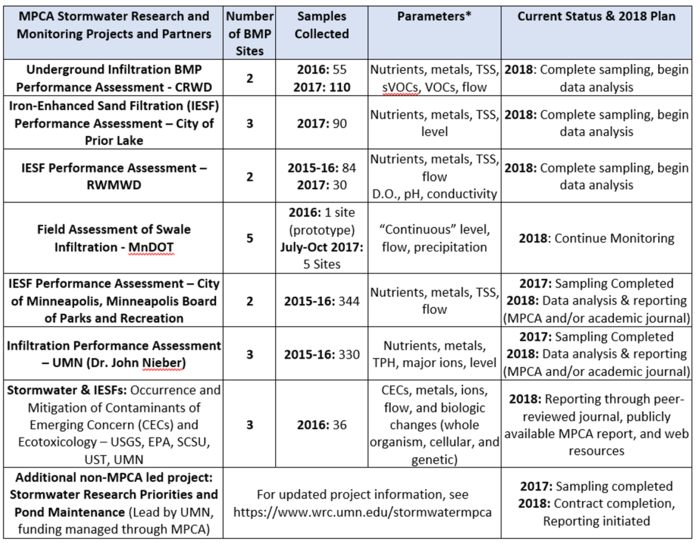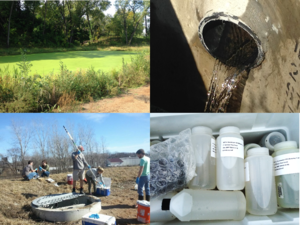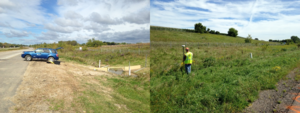
Stormwater research
As the field of stormwater management has evolved, numerous laboratory and field studies have produced an immense amount of valuable information. Much of the Manual’s content is drawn from research studies and from observations related to stormwater monitoring and management; the reader is referred to the Manual’s subject-specific pages for discussion and references related to research on a given topic.
As new knowledge and information is generated, new avenues of management and inquiry also illustrate the need for better information and further research on a range of topics. The following is not a comprehensive list of all that is needed, but is intended to highlight topics of current research need or interest. These topics and needs will change as stormwater research and management continues to adapt. We encourage interested readers to send their comments on research needs, current/existing research, the Manual, and educational resources to the Minnesota Pollution Control Agency. We recommend using the Feedback option at the bottom of his page in the website (Note - the Feedback box is available on every page.).
Contents
MPCA update, July 2018
In July, the research manuscript "Effects of Urban Stormwater and Iron‐Enhanced Sand Filtration on D. magna and Pimephales promelas" was accepted for publication in the journal Environmental Toxicology and Chemistry. It focuses on biological outcomes related to reproduction, growth, and survival in water "fleas" and fathead minnows (model organisms) exposed to raw and treated stormwater from several sites and different seasonal events. This paper stems from the stormwater/CEC project discussed below and was authored by Benjamin Westerhoff (SCSU), David Fairbairn (MPCA), Mark Ferrey (MPCA), Adriana Matilla (SCSU), Jordan Kunkel (SCSU), Sarah Elliott (USGS), Richard Kiesling (USGS), Dustin Woodruff (US EPA), and Heiko Schoenfuss (SCSU).
In May, David Fairbairn (Research Scientist, MPCA Stormwater Program) gave the presentation “Prioritizing Research Topics for CECs & Urban Stormwater Runoff.” at Minnesota Department of Health’s annual forum "Science and Policy of Emerging Contaminants in Minnesota" (click here for pdf slides).
MPCA update, January 2018
MPCA continues to work on several stormwater research projects, the statuses of which are shown in the table to the right. Briefly, the overarching goal of these projects is to fulfill MPCA’s mission to “protect and improve the environment and enhance human health”, by engaging and increasing our capacities to monitor environmental quality, offer technical and financial assistance, and enforce environmental regulations. These projects directly stem from and apply to our mission and capacities by developing improved understandings of stormwater behavior, pollution, and pollutant mitigation. This improved knowledge may then be translated into more refined and applicable guidance and policy to benefit stormwater practitioners, stakeholders, and Minnesota as a whole. More information on these projects can be found in the next section below.
Reporting is underway for one project (CECs), with data analysis and reporting for additional projects to be initiated in 2018. David Fairbairn (MPCA Stormwater Research Scientist) provided updates on these projects at the 2017 Minnesota Water Resources Conference in St. Paul, in the platform presentation “MPCA Stormwater Research: Understanding Stormwater Contaminants and BMP Performance”. Please see the table to the right for a brief summary. The complete WRC presentation is available at the following links.
- As a pdf file: File:MPCA Stormwater Research - WRC 10 16 2017.pdf
- As a PowerPont file: File:MPCA Stormwater Research - WRC 10 16 2017.pptx
David presented on the CEC project at the 38th Annual North America Meeting of the Society for Environmental Toxicology and Chemistry (Nov. 2017), and on the preliminary data from the IESF projects at the ASCE Environmental & Water Resources Institute World Congress (June 2018). Presentation slides are provided at the links in the previous sentence.
MPCA Research updates
MPCA's Stormwater Program is currently involved in 9 research projects. A common goal of the conventional water quality parameter monitoring projects is to develop information on pollutant removal by stormwater BMPs (also called stormwater control measures or SCMs). These projects include iron-enhanced sand filtration (IESF), biofiltration, underground infiltration, and surface infiltration systems. When appropriate, data from these projects will be aggregated for analysis with Twin Cities metro Area (TCMA) data available from other sources to achieve broader representation. We are also engaged in an emerging contaminant and bioassay study of stormwater and BMPs, a related project investigating daphnia transcriptomics as a tool for water quality and adverse outcome pathway determination, a prototype for a long-term field study of swale infiltration performance, and a University of Minnesota-led project to investigate stormwater pond conditions and management and develop long-term cross-sector research priorities. These projects are only possible through much-appreciated partnerships along with funding from Clean Water Funds and, for one project, an EPA grant. We are excited to begin generating results from these projects. As each is completed, MPCA will provide summaries, with full reports available through the Stormwater Program website and the manual. In the meantime, here is a brief description and status update for each.
- IESF Monitoring: City of Minneapolis, Minneapolis Board of Parks and Recreation, and MCPA. Two iron-enhanced sand filters (IESF) in north Minneapolis comprise the study sites. For selected storm events, automated samples are collected every 30 to 60 minutes and analyzed separately to provide information on the temporal dynamics of pollutant concentration and loading within individual storms. Composite sampling (one sample per event) is also utilized. Roughly 200 samples are planned for analysis of nutrients, metals, and other water quality parameters. The MPCA-funded portion of the sampling is complete. MPCA expects to begin data analysis this winter.
- IESF Monitoring: RWMWD and MPCA. This project is monitoring an iron-enhanced biofiltration system at Maplewood Mall, where Ramsey-Washington Metro Watershed District (RWMWD) monitors several other SCMs. Like the Minneapolis study, sequential within-storm samples are collected and analyzed to provide information on within-storm pollutant dynamics (3 to 5 samples per event, for selected events). In total, 150 to 200 samples are anticipated. Sampling is planned through Summer 2017.
- IESF Monitoring: Prior Lake and MPCA. Two ponds with IESF retrofits and one "control" pond without an IESF retrofit are monitored for this project. Pond bathymetry and water level data will be used to provide discharge estimates. For selected storm, snowmelt, and low flow events, samples are collected at several times from each pond, IESF bed, and IESF outlet. The goal is to compare the effect of IESF retrofit (yes/no) and maintenance (yes/no) on the pollutant removal efficiency of the pond systems. Roughly 300 samples will be collected for nutrient analysis through Summer 2017. Sampling is planned through Summer 2017.
- Infiltration Monitoring: UMN and MPCA. This project is monitoring various depths within and beneath infiltration systems to provide information on pollutant transport and removal within the BMP and in the unsaturated soil zone. Vadose zone samples will provide information on pollutant fate in the unsaturated zone. Samples are collected at 29 locations across 3 study sites including the Hamline-Midway bioinfiltration system in Como Park (St. Paul), the Beacon Bluff underground infiltration system (St. Paul), and the Sheep Pasture infiltration basin (UMN, St. Paul). Approximately 160 samples were collected as of July 2016, with project completion planned for Summer 2017.
- Infiltration Monitoring: CRWD and MPCA. Like the UMN-partnered study, this study will use vadose zone samples to provide information on pollutant fate in the unsaturated zone. The study site for this project is part of the Upper Villa Park stormwater reuse and infiltration system, managed by Capitol Region Watershed District (CRWD). CRWD and MPCA worked together to plan and install samplers at three depths in the subsurface beneath the infiltration gallery at this site in late 2015. Sampling began in 2016 and will continue through summer 2017.
- Contaminants of Emerging Concern in Stormwater: Occurrence, Biological Effects, and Removal by BMPs: MPCA, St. Cloud State University, University of St. Thomas, United States Geological Survey, UMN, CRWD, Minneapolis, St Paul. Many contaminants of emerging concern (CECs) occur in urban settings and may be transported via oft-complex pathways to surface waters. Urban stormwater has been suggested as a major source of CECs to surface waters, but information on stormwater transport and BMP removal efficiencies for CECs is currently limited. Filtration BMPs have shown promising performance in the few previous, related CEC and/or toxicology studies. MPCA and several partners are investigating CECs and associated biological effects in three stormwater conveyances and three IESFs in the TCMA. Chemicals of interest include more than 300 commercial/industrial products (e.g., plasticizers, stabilizers, surfactants, disinfectants, deicers), veterinary and human pharmaceuticals, urban-use pesticides, and more. Toxicological assessments include outcome-based fathead minnow and daphnia magna (a water flea) bioassays, in vitro toxicity testing of human cell lines, and the daphnia ecotoxicogenomics tool developed under another project (described below). Results will provide valuable chemical and toxicological information on CECs in stormwater and on the performance of full-scale IESF BMPs at mitigating the potentially related chemical and toxicological impacts. A total of thirty-six samples were collected during snowmelt and spring/summer rain events for this project. Chemical and biological analysis of the samples is ongoing. Preliminary reports are planned for late 2017, and final report in 2018.
- Daphnia Ecotoxicogenomics Method Development and Calibration: MPCA, SCSU, UMN. The goal of this project is to determine the viability of using a daphnia based transcriptomics tool as part of MPCA's water quality monitoring efforts. Gene expression in Daphnia magna exposed to water samples is being assessed as an indicator of the presence and bioactivity of stressors in Minnesota’s waters. By relating gene expression data to available macroscopic phenotypic data and toxicological effect databases, it may be possible to identify Adverse Outcome Pathways (AOPs) associated with endocrine or physiological disruption. It may also be possible to predict these adverse outcomes using only the transcriptomic data, which could provide a more specific, comprehensive, and efficient means of assessing the health of water bodies than currently common chemical and biological methods. This project will dovetail with those of several federal agencies and numerous universities currently engaged in transcriptomic methods and database development and environmental testing. Calibration of the transcriptomic data will be accomplished by statistical analysis with common water quality metrics (wetland IBIs and observational outcomes in d. magna exposed to chemically spiked lab water, water from wetlands of various quality, and treated/untreated stormwater). Sampling for this project was completed in 2015. Toxicity testing was completed in 2016. RNA sequencing and data analysis is ongoing. David Fairbairn is managing this project for MPCA.
- Infiltration in Roadside Swales: Long-Term Field Testing: MPCA and MnDOT. The goal of this project it to use a mass balance approach to verify the long-term infiltration performance of swales in natural conditions. Channel discharge measurements will be paired with precipitation data to estimate inflows and outflows to study sites and thereby calculate estimates of infiltrated volumes. It is hoped that results will provide refined information on swale infiltration performance and factors affecting performance on event, seasonal, and annual scales. A prototype installation has been set up at MnDOT's MnROAD facility for testing and refinement this fall. The plan is for the project to be scaled up to additional sites in 2017. Two years of data collection are anticipated. Results will be compared with calculator estimates and will provide needed natural event data for verification of the performance of this important BMP type.
- Stormwater Research Priorities and Pond Maintenance: UMN and MPCA. This research project will develop information required to improve stormwater pond maintenance and performance by investigating phosphorus conditions, dynamics, and options to manage phosphorus loading to Minnesota surface waters, and by investigating the spatial distribution, bioavailability, and management alternatives for polycyclic aromatic hydrocarbons (PAHs) in stormwater ponds. This project will also produce a ten-year framework of stormwater research needs, and provide for education and training to disseminate the results. University of Minnesota faculty and staff from several departments will contribute to this two-year project, which began in April 2016. The Water Resources Center coordinates the project and the MPCA Stormwater Program serves as the State's technical liaison. This project is in the early stages of site investigation and roadmap development.
Research Needs
- Performance of Emerging and Non-Traditional Best Management Practice (BMPs): Data on the water quantity and quality performance of new or less common BMPs is needed, especially for the Minnesota climate. Practices such as bioretention, pervious pavement, green roofs, infiltration, soil amendments, and proprietary sediment removal devices are included in this need. Of particular need are long-term performance data to validate the short-term data that do exist.
- Cold Climate Adaptations: Many of the suggested adaptations for cold climate BMP installation have not been adequately tested with installed system research. Building modified BMPs and collection of performance information is essential if we hope to effectively address year-round water resource management.
- Cold Climate Simulation Tools: MPCA is in the process of developing a new predictive tool for runoff and sediment from construction sites with funds provided by Mn/DOT, Local Road Research Board (LRRB), and MPCA. It is expanding the model to include watershed scale (with more support by Mn/DOT and LRRB). It already provides an upgrade to the TP-40 approach. More work is needed for cold climate routines.
- Pathogen and Toxin Treatment: Few data exist on the effectiveness of BMPs on the removal of pathogens and many toxins of concern. Data collection on in-place effectiveness of various BMPs relative to these pollutants is needed.
- Outdoor Labs Dedicated to Stormwater Study: MPCA staff have been promoting an outdoor laboratory at UMore Park. Long-term progress in understanding the performance of different stormwater systems require that inflow (rainfall and runoff) be controlled in carefully designed experiments. This facility could provide that opportunity if properly developed.
- LID/BSD Construction and Maintenance:
- The Impact of Infiltration Practices:
- The Impact of Salt: The application of sodium chloride (NaCl) to our roads and parking areas has had a negative impact on water quality. The public’s need for safety, which absolutely must come first, directly conflicts with the judicious use of salt to keep road and parking surfaces ice-free. Recent data have shown increases in both shallow groundwater and lake chloride (Cl) levels – a condition that has been detected in other cold climate portions of the world. Minnesota (Mn/DOT) has been a national leader on anti- and de-icing research, but we need continued research on the nature of the Cl contamination, as well as salt management and alternative methods to keep surfaces ice-free. The MPCA has compiled a considerable amount of information on road salt and water quality.
Literature articles addressing research needs
- Review and Research Needs of Bioretention Used for the Treatment of Urban Stormwater. Liu et al., 2014. Water. 6(4), 1069-1099. This article summarizes some on-going research and addresses research needs for bioretention. The full article can be accessed as a .pdf file.
Research Centers
Notable research into nonpoint source/stormwater behavior and BMP performance, particularly for cold climates, is under way at the following locations:
- Center for Watershed Protection.
- Minnesota Cooperative Cold Climate/LID Study. Participants include Dakota SWCD, WashingtonConservation District, Ramsey-Washington Metro Watershed District, Emmons and Olivier Resources, University of Minnesota. Contact Jim Davidson.
- North Carolina State Stormwater Engineering Group, Biological and Agricultural Engineering, North Carolina State University. Contact Dr. Bill Hunt.
- Norwegian University of Science and Technology (NTNU), Trondheim, Norway. Contact Sveinn Thorolfsson.
- Luleå University of Technology, Luleå, Sweden. Contact Maria Viklander.
- Lund Institute of Technology, Lund University, Lund, Sweden. Contact Annette Semadeni-Davies.
- University of Minnesota St. Anthony Falls Laboratory Stormwater Research. The University of Minnesota Stormwater Research Program is currently developing new treatment technologies, providing guidance for assessment and maintenance of treatment practices, investigating groundwater impacts from stormwater infiltration, and improving models for runoff and treatment practices. Contact John Gulliver.
- University of New Hampshire, Stormwater Center. Contact Rob Roseen.
- Virginia Water Resources Research Center, College of Natural Resources and Environment, Virginia Tech University.
- Washington State Department of Transportation.
- Washington Stormwater Center.
- Wisconsin Department of Natural Resources. Contact Jim Bertolacini.
This page was last edited on 2 February 2023, at 17:50.


